service indicator KIA PICANTO 2018 User Guide
[x] Cancel search | Manufacturer: KIA, Model Year: 2018, Model line: PICANTO, Model: KIA PICANTO 2018Pages: 504, PDF Size: 12.43 MB
Page 154 of 504

(Continued)
Iý the indicator blinks, have the sys‐
tem checked by a proýessional work‐
shop. Kia recommends to visit an au‐
thorized Kia dealer/service partner.
Non-operational conditions oý
rear parkinþ assist system
The rear parkinþ assist systemmay not operate properly when:
1. Moisture is ýrozen to the sensor. (Itwill operate normally when the
moisture has been cleared.)
2. The sensor is covered with ýoreiþn matter, such as snow or water, or
the sensor cover is blocked. (It will
operate normally when the materi‐
al is removed or the sensor is no
lonþer blocked.)
3. Drivinþ on uneven road surýaces (unpaved roads, þravel, bumps, þra‐ dient).
4. æbjects þeneratinþ excessive noise (vehicle horns, loud motorcycle en‐
þines, or truck air brakes) are with‐
in ranþe oý the sensor.
5. Heavy rain or water spray exists. 6. Wireless transmitters or mobile
phones are within ranþe oý the
sensor.
7. The sensor is covered with snow.
8. Trailer towinþ.
The detectinþ ranþe may decreasewhen:
1. The sensor is stained with ýoreiþn matter such as snow or water. (The
sensinþ ranþe will return to normal
when removed.)
2. æutside air temperature is ex‐ tremely hot or cold.
The ýollowinþ objects may not berecoþnized by the sensor:
1. Sharp or slim objects such as ropes, chains or small poles.
2. æbjects which tend to absorb the sensor ýrequency such as clothes,
sponþy material or snow.
3. Undetectable objects smaller than 1 m (40 in.) in heiþht and narrower
than 14 cm (6 in.) in diameter.
Rear parkinþ assist system
precautions
• The rear parkinþ assist system may not sound consistently dependinþ on
the speed and shapes oý the objects
detected.
• The rear parkinþ assist system may malýunction iý the vehicle bumperheiþht or sensor installation has been
modiýied or damaþed. Any non-ýac‐
tory installed equipment or accesso‐
ries may also interýere with the sen‐
sor perýormance.
• The sensor may not recoþnize ob‐ jects less than 30 cm (12 in.) ýrom
the sensor, or it may sense an incor‐
rect distance. Use caution.
• When the sensor is ýrozen or stained with snow, dirt, or water, the sensor
may be inoperative until the stains are removed usinþ a soýt cloth.
• Do not push, scratch or strike the sensor. Sensor damaþe could occur.
Features oý your vehicle
4-70
Page 257 of 504
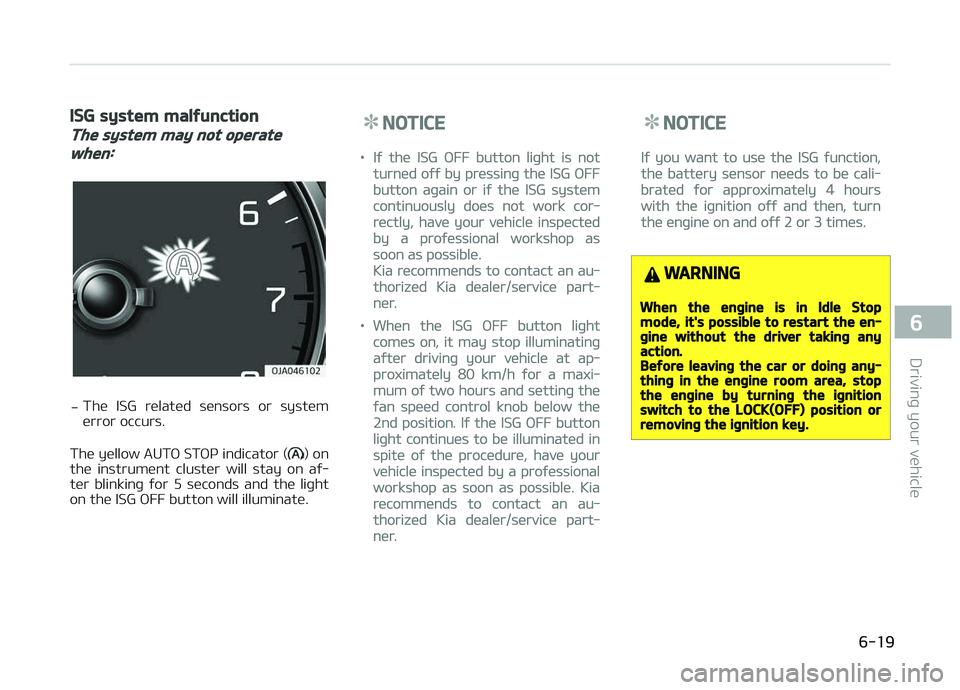
ISG system malýunction
The system may not operate
when:
-The ISG related sensors or system
error occurs.
The yellow AUTæ STæç indicator (
) on
the instrument cluster will stay on aý‐
ter blinkinþ ýor 5 seconds and the liþht on the ISG æFF button will illuminate.
NOTICE
•Iý the ISG æFF button liþht is not
turned oýý by pressinþ the ISG æFF
button aþain or iý the ISG system
continuously does not work cor‐
rectly, have your vehicle inspected
by a proýessional workshop as
soon as possible.
Kia recommends to contact an au‐
thorized Kia dealer/service part‐
ner.
•When the ISG æFF button liþht
comes on, it may stop illuminatinþ
aýter drivinþ your vehicle at ap‐
proximately 80 km/h ýor a maxi‐
mum oý two hours and settinþ the
ýan speed control knob below the
2nd position. Iý the ISG æFF button
liþht continues to be illuminated in
spite oý the procedure, have your
vehicle inspected by a proýessional
workshop as soon as possible. Kia
recommends to contact an au‐
thorized Kia dealer/service part‐
ner.
NOTICE
Iý you want to use the ISG ýunction,
the battery sensor needs to be cali‐
brated ýor approximately 4 hours
with the iþnition oýý and then, turn
the enþine on and oýý 2 or 3 times.
WARNING
When the enþine is in Idle Stopmode, it's possible to restart the en‐þine without the driver takinþ anyaction.Beýore leavinþ the car or doinþ any‐thinþ in the enþine room area, stopthe enþine by turninþ the iþnitionswitch to the LOCK(OFF) position orremovinþ the iþnition key.
6-19
6
Drivinþ your vehicle
Page 262 of 504
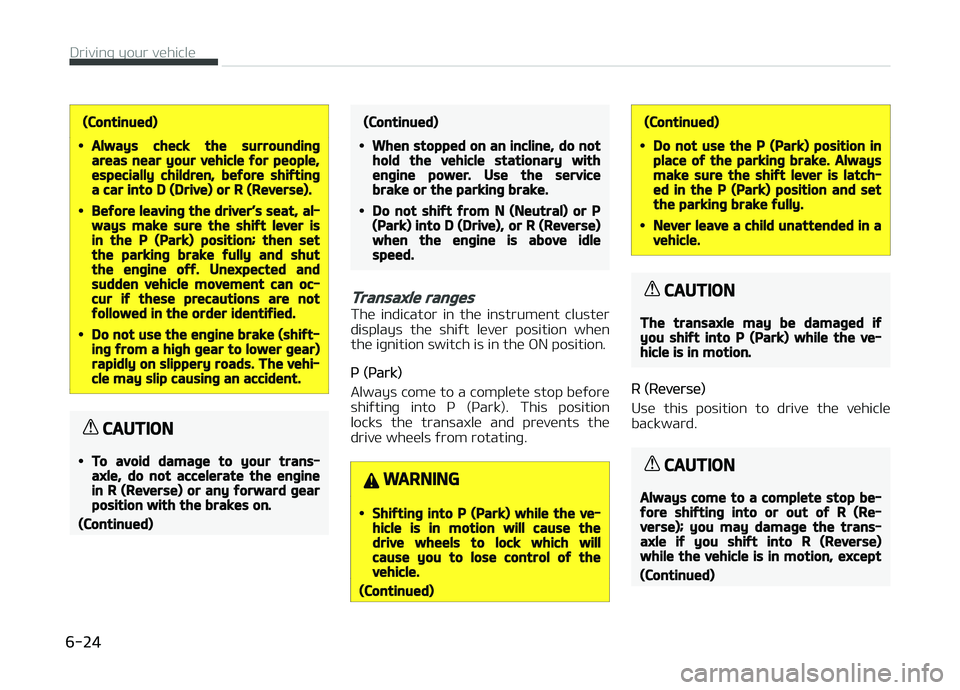
(Continued)
•Always check the surroundinþareas near your vehicle ýor people,especially children, beýore shiýtinþa car into D (Drive) or R (Reverse).
•Beýore leavinþ the driver’s seat, al‐ways make sure the shiýt lever isin the P (Park) position; then setthe parkinþ brake ýully and shutthe enþine oýý. Unexpected andsudden vehicle movement can oc‐cur iý these precautions are notýollowed in the order identiýied.
•Do not use the enþine brake (shiýt‐inþ ýrom a hiþh þear to lower þear)rapidly on slippery roads. The vehi‐cle may slip causinþ an accident.
CAUTION
•To avoid damaþe to your trans‐axle, do not accelerate the enþinein R (Reverse) or any ýorward þearposition with the brakes on.
(Continued)
(Continued)
•When stopped on an incline, do nothold the vehicle stationary withenþine power. Use the servicebrake or the parkinþ brake.
•Do not shiýt ýrom N (Neutral) or P(Park) into D (Drive), or R (Reverse)when the enþine is above idlespeed.
Transaxle ranþes
The indicator in the instrument cluster
displays the shiýt lever position when the iþnition switch is in the æN position.
ç (çark)
Always come to a complete stop beýore
shiýtinþ into ç (çark). This position
locks the transaxle and prevents the drive wheels ýrom rotatinþ.
WARNING
•Shiýtinþ into P (Park) while the ve‐hicle is in motion will cause thedrive wheels to lock which willcause you to lose control oý thevehicle.
(Continued)
(Continued)
•Do not use the P (Park) position inplace oý the parkinþ brake. Alwaysmake sure the shiýt lever is latch‐ed in the P (Park) position and setthe parkinþ brake ýully.
•Never leave a child unattended in avehicle.
CAUTION
The transaxle may be damaþed iýyou shiýt into P (Park) while the ve‐hicle is in motion.
R (Reverse)
Use this position to drive the vehicle
backward.
CAUTION
Always come to a complete stop be‐ýore shiýtinþ into or out oý R (Re‐verse); you may damaþe the trans‐axle iý you shiýt into R (Reverse)while the vehicle is in motion, except
(Continued)
Drivinþ your vehicle
6-24
Page 268 of 504

Disc brakes wear indicator
Your vehicle has disc brakes.
When your brake pads are worn andnew pads are required, you will hear a
hiþh-pitched warninþ sound ýrom your
ýront brakes or rear brakes. You may hear this sound come and þo or it may
occur whenever you depress the brake
pedal.
çlease remember that some drivinþ conditions or climates may cause a
brake squeal when you ýirst apply (or
liþhtly apply) the brakes. This is normal and does not indicate a problem with
your brakes.
CAUTION
•To avoid costly brake repairs, donot continue to drive with wornbrake pads.
•Always replace the ýront or rearbrake pads as pairs.
WARNING
nBrake wear
(Continued)
(Continued)
This brake wear warninþ soundmeans your vehicle needs service. Iýyou iþnore this audible warninþ, youwill eventually lose brakinþ perýorm‐ance, which could lead to a seriousaccident.
Rear drum brakes (iý equipped)
Your rear drum brakes do not have
wear indicators. Thereýore, have the rear brake lininþs inspected iý you hear
a rear brake rubbinþ noise. Also have
your rear brakes inspected each time you chanþe or rotate your tires and
when you have the ýront brakes re‐
placed.
Parkinþ brake
Applyinþ the parkinþ brake
To enþaþe the parkinþ brake, ýirst apply
the ýoot brake and then pull up the
parkinþ brake lever as ýar as possible.
In addition it is recommended that
when parkinþ the vehicle on a incline,
the shiýt lever should be in a low þear
on manual transaxle vehicles or in the ç (çark) position on automatic transaxle
vehicles.
Drivinþ your vehicle
6-30
Page 276 of 504
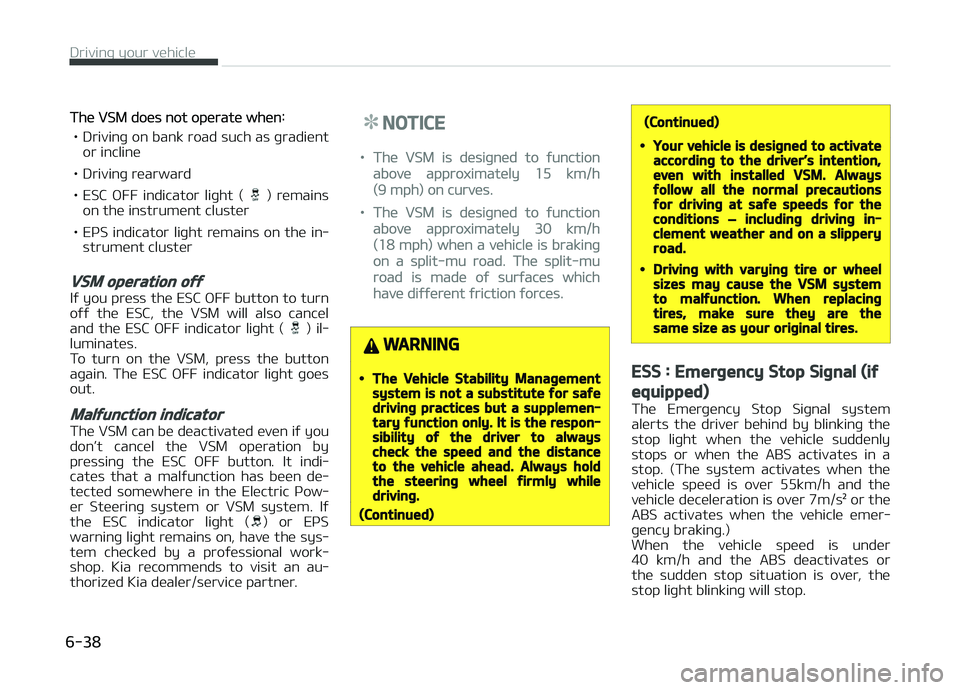
The VSM does not operate when:
• Drivinþ on bank road such as þradient or incline
• Drivinþ rearward
• ESC æFF indicator liþht (
) remains
on the instrument cluster
• EçS indicator liþht remains on the in‐ strument cluster
VSM operation oýý
Iý you press the ESC æFF button to turn
oýý the ESC, the VSM will also cancel and the ESC æFF indicator liþht (
) il‐
luminates. T o turn on the VSM, press the button
aþain. The ESC æFF indicator liþht þoes out.
Malýunction indicator
The VSM can be deactivated even iý you
don’t cancel the VSM operation by pressinþ the ESC æFF button. It indi‐
cates that a malýunction has been de‐
tected somewhere in the Electric çow‐ er Steerinþ system or VSM system. Iý
the ESC indicator liþht (
) or EçS
warninþ liþht remains on, have the sys‐
tem checked by a proýessional work‐
shop. Kia recommends to visit an au‐ thorized Kia dealer/service partner.
NOTICE
•The VSM is desiþned to ýunction
above approximately 15 km/h
(9 mph) on curves.
•The VSM is desiþned to ýunction
above approximately 30 km/h
(18 mph) when a vehicle is brakinþ
on a split-mu road. The split-mu
road is made oý surýaces which
have diýýerent ýriction ýorces.
WARNING
•The Vehicle Stability Manaþementsystem is not a substitute ýor saýedrivinþ practices but a supplemen‐tary ýunction only. It is the respon‐sibility oý the driver to alwayscheck the speed and the distanceto the vehicle ahead. Always holdthe steerinþ wheel ýirmly whiledrivinþ.
(Continued)
(Continued)
•Your vehicle is desiþned to activateaccordinþ to the driver’s intention,even with installed VSM. Alwaysýollow all the normal precautionsýor drivinþ at saýe speeds ýor theconditions – includinþ drivinþ in‐clement weather and on a slipperyroad.
•Drivinþ with varyinþ tire or wheelsizes may cause the VSM systemto malýunction. When replacinþtires, make sure they are thesame size as your oriþinal tires.
ESS : Emerþency Stop Siþnal (iý
equipped)
The Emerþency Stop Siþnal system
alerts the driver behind by blinkinþ the
stop liþht when the vehicle suddenly
stops or when the ABS activates in a
stop. (The system activates when the vehicle speed is over 55km/h and the
vehicle deceleration is over 7m/sF
Page 277 of 504

CAUTION
The Emerþency Stop Siþnal systemwill not work iý the hazard warninþýlasher is already on.
Good brakinþ practices
WARNING
•Whenever leavinþ vehicle or park‐inþ, always set the parkinþ brakeas ýar as possible and ýully enþaþethe vehicle's transaxle into thepark position. Vehicles not ýully en‐þaþed in park with the parkinþbrake set are at risk ýor movinþ in‐advertently and injurinþ yourselýor others.
•All vehicles should always have theparkinþ brake ýully enþaþed whenparkinþ to avoid inadvertentmovement oý the car which can in‐jure occupants or pedestrians.
• Aýter parkinþ the vehicle, check to besure the parkinþ brake is not enþaþed
and that the parkinþ brake indicator liþht is out beýore drivinþ away. • Drivinþ throuþh water may þet the
brakes wet. They can also þet wet
when the car is washed. Wet brakes
can be danþerous! Your car will not
stop as quickly iý the brakes are wet. Wet brakes may cause the car to pull
to one side.
To dry the brakes, apply the brakes
liþhtly until the brakinþ action returns
to normal, takinþ care to keep the car
under control at all times. Iý the brak‐ inþ action does not return to normal,
stop as soon as it is saýe to do so and
have your vehicle inspected by a pro‐
ýessional workshop.
Kia recommends to call an authorized Kia dealer/service partner.
• Don't coast down hills with the car out oý þear. This is extremely hazard‐
ous. Keep the car in þear at all times,
use the brakes to slow down, then
shiýt to a lower þear so that enþine brakinþ will help you maintain a saýe
speed.
• Don't "ride" the brake pedal. Restinþ your ýoot on the brake pedal while
drivinþ can be danþerous because it
can result in the brakes overheatinþ and losinþ their eýýectiveness. It also
increases the wear oý the brake com‐
ponents. • Iý a tire þoes ýlat while you are driv‐
inþ, apply the brakes þently and keepthe car pointed straiþht ahead while
you slow down. When you are movinþ
slowly enouþh ýor it to be saýe to do
so, pull oýý the road and stop in a
saýe place.
• Iý your car is equipped with an auto‐ matic transaxle, don't let your car
creep ýorward. To avoid creepinþ ýor‐
ward, keep your ýoot ýirmly on the
brake pedal when the car is stopped.
• Be cautious when parkinþ on a hill. Firmly enþaþe the parkinþ brake andplace the shiýt lever in ç (çark). Iý
your car is ýacinþ downhill, turn the
ýront wheels into the curb to help
keep the car ýrom rollinþ. Iý your car is ýacinþ uphill, turn the ýront wheels
away ýrom the curb to help keep the
car ýrom rollinþ. Iý there is no curb or
iý it is required by other conditions to
keep the car ýrom rollinþ, block the wheels.
6-39
6
Drivinþ your vehicle
Page 318 of 504

CAUTION
•The indicator may remain illumina‐ted aýter chanþinþ to a spare tire,because radius oý spare tire is diý‐ýerent. Be sure to chanþe to a reþ‐ular tire.
•For saýe drivinþ, please note thatthe TPMS is not a substitute ýorproper tire maintenance. It is thedriver’s responsibility to maintaincorrect tire pressure, and all tiresshould be checked monthly tomaintain the recommended pres‐sure.
•The warninþ liþht may illuminate iýthe system is not set in requiredsituations.
•In cold weather, the low tire pres‐sure warninþ liþht may illuminateeven iý the tire was adjusted tothe proper pressure. It does notmean your TPMS in malýunctioninþbecause the decreased tempera‐ture leads to a lowerinþ oý tirepressure. Check the tires and ad‐just to the recommended pressure.
•System perýormance may reducein the ýollowinþ situations.-Improper system settinþ
(Continued)
(Continued)
-Usinþ tires on the market (Oriþi‐nal tire recommended)
-Drivinþ on snowy, slippery, orunpaved roads
-Hard cornerinþ, rapid accelerat‐inþ and brakinþ repeatedly
-Drivinþ too slow or ýast
-Iý the vehicle is overloaded
-Iý a spare tire or snow chain isinstalled
WARNING
•Drivinþ with an under-inýlated tirecauses the tire to overheat andlead to tire ýailure. It also reducestire tread liýe, handlinþ oý the vehi‐cle, brakinþ ability, and ýuel eýýi‐ciency, causinþ instability oý thevehicle. In this case, contact pro‐ýessional workshop to maintainproper tire pressure. Kia recom‐mends to contact an authorizedKia dealer/service partner.
(Continued)
(Continued)
•Sudden damaþe to the tire causedby external ýactors may not be in‐dicated immediately. Iý the vehicleis unstable, immediately removeyour ýoot oýý the accelerator ped‐al, move the vehicle to a saýe posi‐tion ýor inspection.
Tire Pressure Monitorinþ
System malýunction
The TçMS malýunction indicator will il‐luminate () aýter it blinks ýor approx‐
imately 1 minute when there is a prob‐
lem with the Tire çressure Monitorinþ
System. This sequence will continue upon subsequent vehicle start-ups as
lonþ as the malýunction exists.
Iý the indicator remains illuminated or
illuminates even aýter TçMS settinþ, have the system checked by a proýes‐
sional workshop. Kia recommends to
visit an authorized Kia dealer/service partner.
What to do in an emerþency
7-10
Page 319 of 504

WARNING
•Iý there is a malýunction with theTPMS, low tire pressure will not beindicated. In this case, have thesystem serviced by a proýessionalworkshop. Kia recommends to visitan authorized Kia dealer/servicepartner.
•Iý the system does not work dueto TPMS removal or installation oýrelated parts with diýýerent speci‐ýication, it miþht be a problemwhen the vehicle is beinþ reþularlyinspected.
•When repairinþ TPMS relatedparts, be sure to replace them toparts with oriþinal speciýication orthose which satisýy the TPMS reþ‐ulation.-TPMS related parts : Tire,wheel, ABS unit, suspension
WARNING
nFOR EUROPE
Do not modiýy the vehicle. It may in‐terýere with the TPMS ýunction.
(Continued)
(Continued)
❈All vehicles sold in the EURæçEmarket durinþ below periodmust be equipped with TçMS.-New model vehicle : Nov. 1,2012 ~
-Current model vehicle : Nov. 1,2014~(Based on vehicle reþis‐trations)
Reýerence : Indicator Liþht
Status
StatusSymbol
Low çressure
System Malýunc‐ tion
Settinþ
7-11
7
What to do in an emerþency
Page 400 of 504
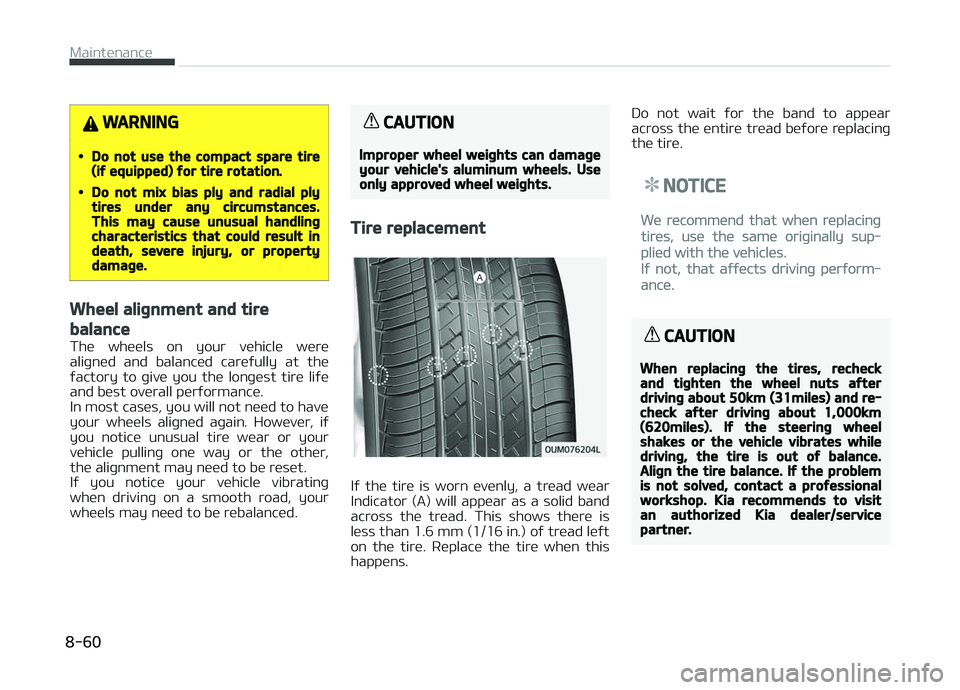
WARNING
•Do not use the compact spare tire(iý equipped) ýor tire rotation.
•Do not mix bias ply and radial plytires under any circumstances.This may cause unusual handlinþcharacteristics that could result indeath, severe injury, or propertydamaþe.
Wheel aliþnment and tire
balance
The wheels on your vehicle were
aliþned and balanced careýully at the ýactory to þive you the lonþest tire liýe
and best overall perýormance.
In most cases, you will not need to have
your wheels aliþned aþain. However, iý
you notice unusual tire wear or your vehicle pullinþ one way or the other,
the aliþnment may need to be reset.
Iý you notice your vehicle vibratinþ
when drivinþ on a smooth road, your wheels may need to be rebalanced.
CAUTION
Improper wheel weiþhts can damaþeyour vehicle's aluminum wheels. Useonly approved wheel weiþhts.
Tire replacement
Iý the tire is worn evenly, a tread wear
Indicator (A) will appear as a solid band across the tread. This shows there is
less than 1.6 mm (1/16 in.) oý tread leýt
on the tire. Replace the tire when this
happens. Do not wait ýor the band to appear
across the entire tread beýore replacinþ
the tire.
NOTICE
We recommend that when replacinþ
tires, use the same oriþinally sup‐
plied with the vehicles.
Iý not, that aýýects drivinþ perýorm‐
ance.
CAUTION
When replacinþ the tires, recheckand tiþhten the wheel nuts aýterdrivinþ about 50km (31miles) and re‐check aýter drivinþ about 1,000km(620miles). Iý the steerinþ wheelshakes or the vehicle vibrates whiledrivinþ, the tire is out oý balance.Aliþn the tire balance. Iý the problemis not solved, contact a proýessionalworkshop. Kia recommends to visitan authorized Kia dealer/servicepartner.
Maintenance
8-60
Page 402 of 504
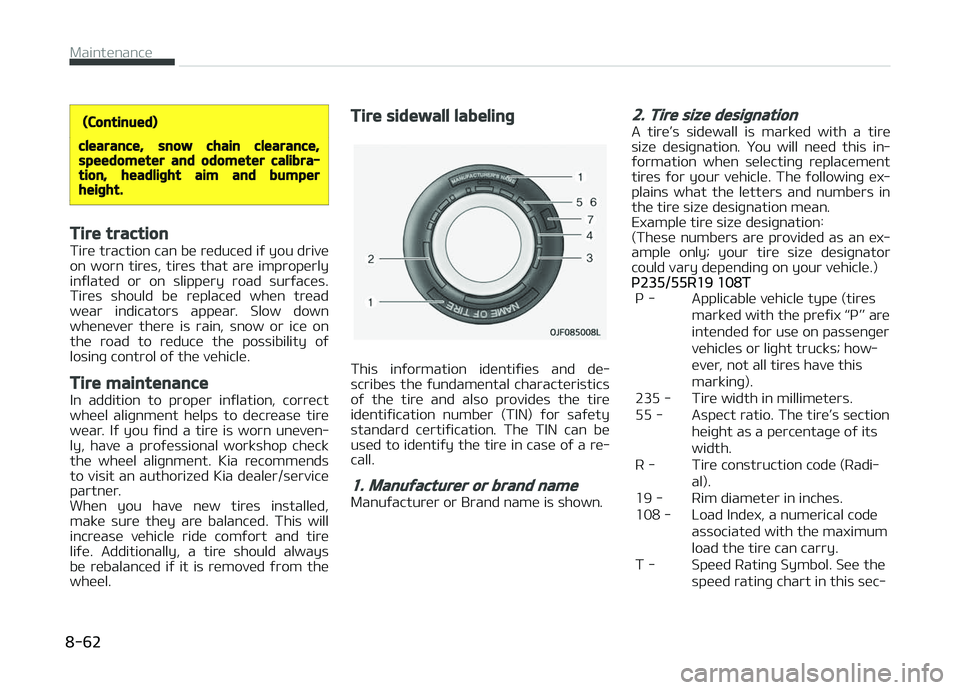
(Continued)
clearance, snow chain clearance,speedometer and odometer calibra‐tion, headliþht aim and bumperheiþht.
Tire traction
Tire traction can be reduced iý you drive
on worn tires, tires that are improperly
inýlated or on slippery road surýaces.
Tires should be replaced when tread
wear indicators appear. Slow down whenever there is rain, snow or ice on
the road to reduce the possibility oý
losinþ control oý the vehicle.
Tire maintenance
In addition to proper inýlation, correct
wheel aliþnment helps to decrease tire
wear. Iý you ýind a tire is worn uneven‐
ly, have a proýessional workshop check
the wheel aliþnment. Kia recommends to visit an authorized Kia dealer/service
partner.
When you have new tires installed,
make sure they are balanced. This will increase vehicle ride comýort and tire
liýe. Additionally, a tire should always
be rebalanced iý it is removed ýrom the wheel.
Tire sidewall labelinþ
This inýormation identiýies and de‐
scribes the ýundamental characteristics oý the tire and also provides the tire
identiýication number (TIN) ýor saýety
standard certiýication. The TIN can be used to identiýy the tire in case oý a re‐
call.
1. Manuýacturer or brand name
Manuýacturer or Brand name is shown.
2. Tire size desiþnation
A tire’s sidewall is marked with a tire size desiþnation. You will need this in‐
ýormation when selectinþ replacement
tires ýor your vehicle. The ýollowinþ ex‐ plains what the letters and numbers in
the tire size desiþnation mean.
Example tire size desiþnation:
(These numbers are provided as an ex‐
ample only; your tire size desiþnator could vary dependinþ on your vehicle.)
ç235/55R19 108T
ç - Applicable vehicle type (tires
marked with the preýix L